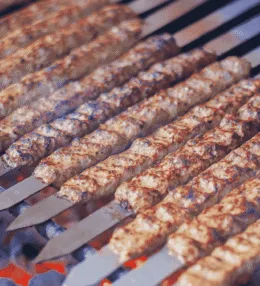
- View
Table of Contents
ToggleTesti Kebab, a traditional Turkish delicacy, is as much about the experience as it is about the flavours. This clay pot cooked stew features tender meats and vegetables slow cooked in their own juices, creating a savoury and aromatic dish that is as delicious as it is memorable.
Originating from the Cappadocia region, Testi Kebab captures the essence of Turkey’s rich culinary traditions, where flavours are bold, presentations are dramatic, and every meal is an event.
Want to dive deeper into Turkish Cuisine? Don’t miss our post on 44 Traditional Turkish Foods to Try
What Is Testi Kebab?
Testi Kebab, also known as Pottery Kebab, is a unique dish prepared in a sealed clay pot (or testi) that holds a mix of meat, vegetables, and spices. The pot is traditionally sealed with dough and cooked over a flame, allowing the ingredients to stew together while locking in the flavours.
When ready, the pot is dramatically cracked open at the table, releasing a rush of fragrant steam and signalling that it’s time to dig in. The slow cooking method gives the meat, often lamb, chicken, or beef, a tender, melt in your mouth quality that pairs beautifully with the rich, spiced broth and tender vegetables.
This dish is widely enjoyed throughout Turkey, particularly in Cappadocia, where the technique of cooking in clay vessels has been preserved and passed down through generations. More than just a meal, Testi Kebab is an experience that brings people together, as diners eagerly await the moment when the pot is cracked open.
Ingredients and Taste
The ingredients in Testi Kebab are simple yet rich, designed to develop deep flavours during the slow cooking process. Meat forms the base of the dish, with lamb, beef, or chicken commonly used.
Added to this are a variety of fresh vegetables, such as tomatoes, bell peppers, onions, and sometimes eggplant, which break down and meld into the broth, giving it a lush, hearty consistency.
Garlic, thyme, and bay leaves add layers of flavour, while a blend of Turkish spices, often including cumin, black pepper, and sometimes a touch of paprika, enhances the meat and vegetables.
The pot is then sealed with dough, trapping the steam inside and allowing the ingredients to cook in their own juices, intensifying the flavours.
When it comes to taste, Testi Kebab is a symphony of savoury and earthy notes. The meat is incredibly tender, having absorbed the spices and juices from the vegetables. Each bite offers a taste of the Mediterranean, where the sweetness of the tomatoes complements the subtle heat of the spices.
The broth is thick and robust, with a balance of flavours that’s both satisfying and deeply comforting. The end result is a dish that feels hearty yet refined, a true reflection of the richness of Turkish cuisine.
A Taste of History
Testi Kebab has ancient roots in Turkey, where cooking with clay pots has long been a method for sealing in flavours and keeping food tender. This dish is particularly tied to the Cappadocia region, known for its unique landscapes and pottery traditions.
Clay cooking vessels have been an integral part of Cappadocian cuisine for centuries, originally used by nomadic tribes who needed durable, versatile cookware. The tradition of sealing a clay pot with dough reflects an ancient practice of slow cooking, where the natural flavours of the ingredients are intensified through steam.
Over time, Testi Kebab became a popular dish in Turkish cuisine, known not only for its unique cooking method but also for the theatre of presentation.
Today, it remains a favourite in Turkish restaurants and family gatherings, where it is often prepared for special occasions. The moment of cracking open the pot is a communal event, embodying the Turkish spirit of hospitality and shared meals.
How to Make Testi Kebab (Pottery Kebab)
Testi Kebab is one of Turkey’s most fascinating dishes, traditionally prepared in a sealed clay pot that locks in flavour and moisture. Tender lamb, vegetables, and aromatic spices slowly cook together, creating a rich stew that bursts with depth once the pot is cracked open. Expect an earthy aroma and melt in the mouth texture. See the recipe card at the bottom for printable directions
Ingredients
- 600 g boneless lamb shoulder, cut into 2.5 cm cubes
- 2 tbsp olive oil
- 1 large onion, finely chopped
- 2 cloves garlic, crushed
- 2 medium tomatoes, chopped
- 1 green pepper, chopped
- 1 red pepper, chopped
- 1 medium carrot, sliced
- 150 g mushrooms, halved
- 1 tbsp tomato paste
- ½ tsp paprika
- ½ tsp ground cumin
- ¼ tsp ground black pepper
- ½ tsp salt (adjust to taste)
- 200 ml water or light beef stock
- Small handful of fresh parsley, chopped (for garnish)
- Dough made from 100 g flour and 50 ml water (for sealing the pot)
- 1 traditional clay pot (testi or ovenproof earthenware pot with lid)
Cooking Instructions
Step 1: Prepare the meat and vegetables
To begin, trim the lamb and cut into even cubes. Chop all vegetables into bite-sized pieces. This ensures uniform cooking and helps the ingredients blend harmoniously later.
Step 2: Sear the meat
In a large pan, heat the olive oil over medium heat. Add the lamb cubes and brown on all sides until lightly caramelised. This step deepens the flavour and helps lock in the juices before the slow cook.
Step 3: Add aromatics and paste
Stir in the chopped onion and garlic, cooking until softened. Add the tomato paste and stir for one minute to allow its richness to develop. This forms the base of the kebab’s deep sauce.
Step 4: Combine vegetables and seasoning
Add the tomatoes, peppers, carrot, and mushrooms. Sprinkle in paprika, cumin, salt, and pepper. Stir well so that the spices coat every ingredient evenly. Continue to cook for 2–3 minutes.
Step 5: Add liquid and simmer
Pour in the water or light beef stock. Let the mixture simmer gently for 5 minutes. The goal is to allow the flavours to start mingling before transferring to the clay pot.
Step 6: Transfer to the clay pot
Spoon the mixture into the clay pot, ensuring the liquid just covers the ingredients. Leave a small gap at the top to prevent overflow during cooking.
Step 7: Seal the pot
Roll the flour and water mixture into a rope and press it around the edge of the lid to create a tight seal. This traditional technique traps steam, ensuring the meat becomes exceptionally tender.
Step 8: Bake slowly
Place the sealed pot on a baking tray and bake in a preheated oven at 180°C for about 1½ hours. The dough seal may darken slightly as it bakes, which is perfectly normal.
Step 9: Open the pot
Remove the pot from the oven and rest it for 10 minutes. Carefully break the dough seal using a small knife or spoon, then gently lift the lid. Be cautious of escaping steam as the aroma bursts out.
Step 10: Serve and garnish
Transfer the kebab into a serving dish or serve directly from the pot for dramatic effect. Garnish with fresh parsley and accompany with rice pilaf or flatbread to soak up the rich sauce.
Variations and Substitutions
- Meat: Beef or chicken can replace lamb for a lighter version.
- Vegetables: Add courgettes or aubergine for a heartier texture.
- Clay pot substitute: If you lack a testi, use a covered cast-iron or ceramic casserole dish.
- Stock: Replace with vegetable stock for a milder flavour.
Cooking Tips for Perfect Testi Kebab
- Always sear the lamb first to enhance depth of flavour.
- Use fresh, ripe tomatoes for natural sweetness.
- The dough seal is essential for traditional results; it creates a steam chamber for tender meat.
- Allow the pot to rest before opening to let the juices redistribute.
- If using a modern ovenproof pot, you can add a foil layer beneath the lid to mimic the sealed effect.

Turkish Testi Kebab (Pottery Kebab)
Equipment
- Clay or ceramic pot with lid (or foil to seal)
- Oven or open flame
- Knife and cutting board
- Mixing bowl
- Spoon or spatula
Ingredients
- 600 g boneless lamb shoulder cut into 2.5 cm cubes
- 2 tbsp olive oil
- 1 large onion finely chopped
- 2 cloves garlic crushed
- 2 medium tomatoes chopped
- 1 green pepper chopped
- 1 red pepper chopped
- 1 medium carrot sliced
- 150 g mushrooms halved
- 1 tbsp tomato paste
- ½ tsp paprika
- ½ tsp ground cumin
- ¼ tsp ground black pepper
- ½ tsp salt adjust to taste
- 200 ml water or light beef stock
- Small handful of fresh parsley chopped (for garnish)
- Dough made from 100 g flour and 50 ml water for sealing the pot
- 1 traditional clay pot testi or ovenproof earthenware pot with lid
Instructions
- To begin, trim the lamb and cut into even cubes. Chop all vegetables into bite-sized pieces. This ensures uniform cooking and helps the ingredients blend harmoniously later.
- In a large pan, heat the olive oil over medium heat. Add the lamb cubes and brown on all sides until lightly caramelised. This step deepens the flavour and helps lock in the juices before the slow cook.
- Stir in the chopped onion and garlic, cooking until softened. Add the tomato paste and stir for one minute to allow its richness to develop. This forms the base of the kebab’s deep sauce.
- Add the tomatoes, peppers, carrot, and mushrooms. Sprinkle in paprika, cumin, salt, and pepper. Stir well so that the spices coat every ingredient evenly. Continue to cook for 2–3 minutes.
- Pour in the water or light beef stock. Let the mixture simmer gently for 5 minutes. The goal is to allow the flavours to start mingling before transferring to the clay pot.
- Spoon the mixture into the clay pot, ensuring the liquid just covers the ingredients. Leave a small gap at the top to prevent overflow during cooking.
- Roll the flour and water mixture into a rope and press it around the edge of the lid to create a tight seal. This traditional technique traps steam, ensuring the meat becomes exceptionally tender.
- Place the sealed pot on a baking tray and bake in a preheated oven at 180°C for about 1½ hours. The dough seal may darken slightly as it bakes, which is perfectly normal.
- Remove the pot from the oven and rest it for 10 minutes. Carefully break the dough seal using a small knife or spoon, then gently lift the lid. Be cautious of escaping steam as the aroma bursts out.
- Transfer the kebab into a serving dish or serve directly from the pot for dramatic effect. Garnish with fresh parsley and accompany with rice pilaf or flatbread to soak up the rich sauce.
Nutrition
You May Also Like






